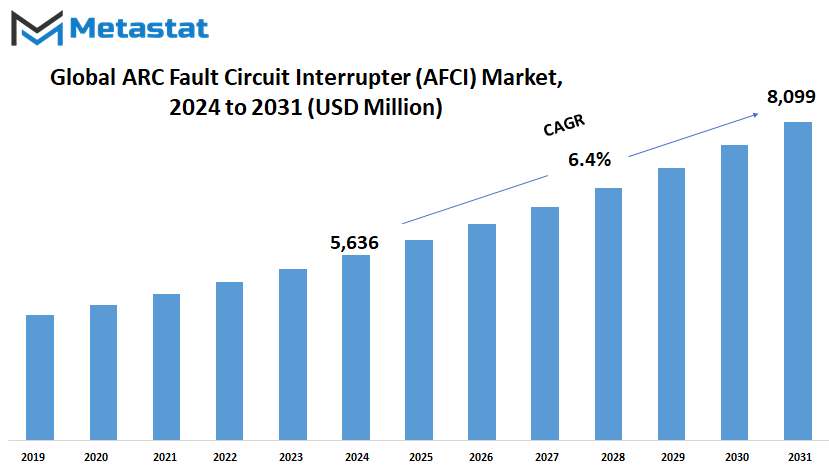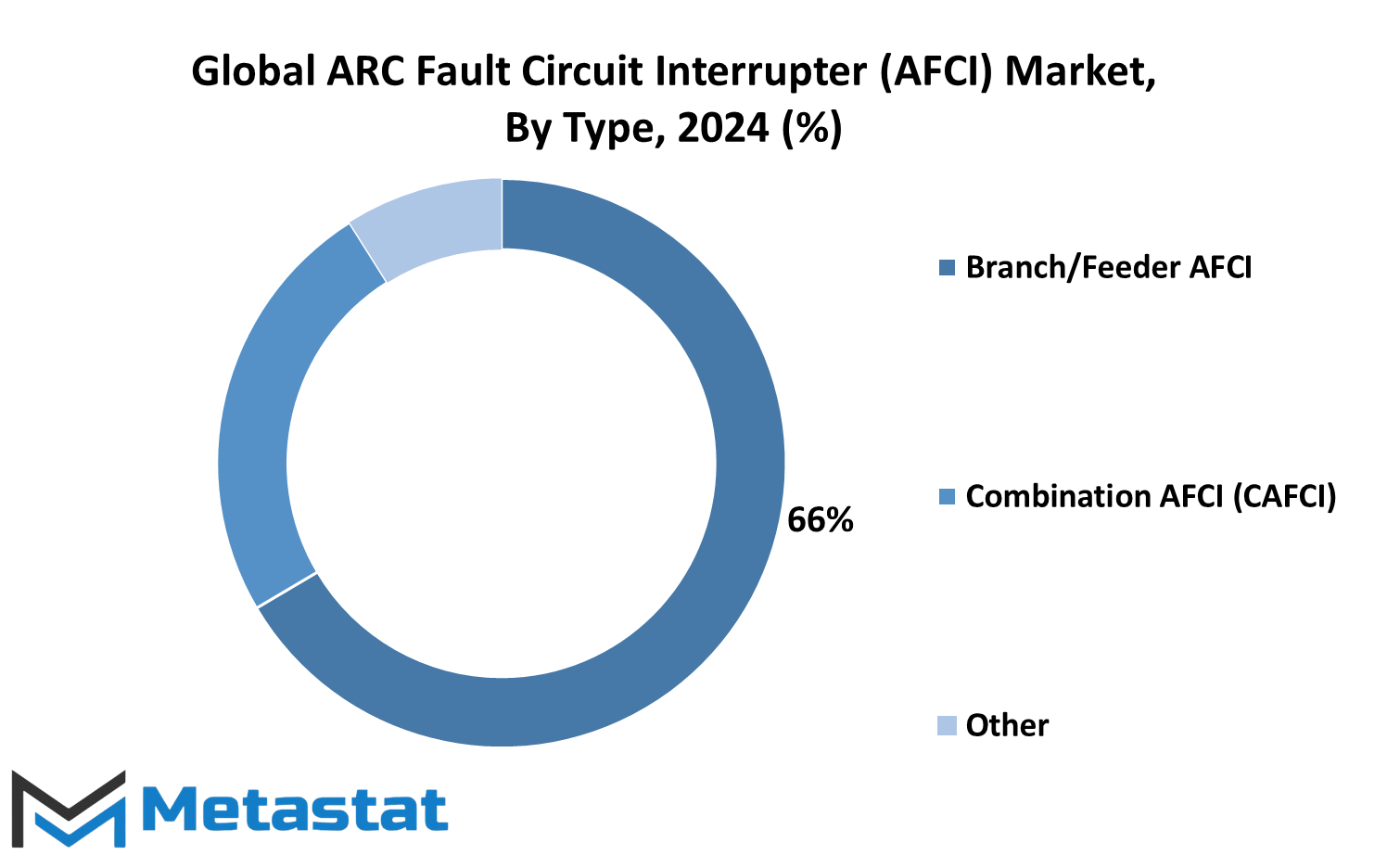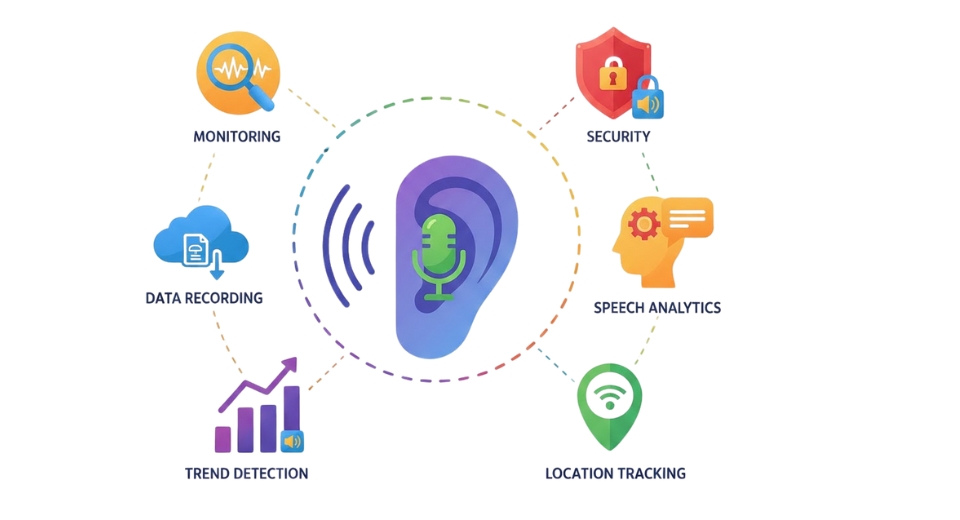MARKET OVERVIEW
The Global ARC Fault Circuit Interrupter (AFCI) market is a crucial component of the electrical safety industry, ensuring the prevention of electrical fires caused by arc faults. AFCIs are devices designed to detect hazardous arcing conditions in electrical circuits and interrupt the flow of electricity to prevent potential fire hazards. The importance of AFCIs in safeguarding residential and commercial properties cannot be overstated, and their role in enhancing electrical safety standards globally is indispensable.
The AFCI market has experienced significant advancements due to increasing awareness of electrical safety and stringent regulations. Governments and regulatory bodies worldwide have recognized the necessity of incorporating AFCIs into electrical systems, leading to mandatory installation codes in many regions. This regulatory push is driven by the alarming statistics of electrical fires caused by arc faults, which result in substantial property damage and pose serious risks to human lives.
Technological innovations within the AFCI market have been at the forefront of its evolution. Manufacturers are continually developing advanced AFCI technologies that offer enhanced detection capabilities, improved reliability, and better integration with modern electrical systems. The shift towards smart homes and the integration of Internet of Things (IoT) devices have further propelled the demand for sophisticated AFCI solutions. These smart AFCIs are designed to communicate with other smart devices, providing real-time monitoring and control, thereby offering an added layer of safety and convenience for users.
In the residential sector, the adoption of AFCIs is becoming increasingly prevalent. Homeowners are more conscious of the potential risks associated with electrical faults and are proactively seeking solutions that can mitigate these dangers. The rise in residential construction activities, especially in emerging economies, is expected to drive the demand for AFCIs. As new homes are built and older ones are retrofitted to meet modern safety standards, the market for residential AFCI installations will expand.
The commercial and industrial sectors also present significant growth opportunities for the AFCI market. In commercial buildings, where electrical systems are often more complex and handle higher loads, the risk of arc faults is elevated. Businesses and institutions are investing in AFCI technologies to protect their assets and ensure the safety of their occupants. Industrial applications, particularly in manufacturing and processing plants, require robust electrical safety mechanisms due to the presence of heavy machinery and intricate electrical networks. AFCIs designed for industrial use are engineered to withstand harsh environments and deliver reliable performance under demanding conditions.
Market dynamics are further influenced by the ongoing trends in energy efficiency and sustainability. As the world shifts towards renewable energy sources and greener technologies, AFCI manufacturers are aligning their products to meet these new standards. Solar power installations, for example, incorporate AFCIs to prevent arc faults that can occur in photovoltaic systems. This alignment with sustainable practices not only enhances the safety of renewable energy systems but also supports the broader goal of reducing the carbon footprint.
The Global ARC Fault Circuit Interrupter (AFCI) market plays a vital role in advancing electrical safety across various sectors. The combination of regulatory support, technological innovation, and growing awareness of electrical hazards is set to drive the market forward. As the demand for safer, smarter, and more efficient electrical systems continues to rise, the AFCI market will remain a key player in ensuring the protection of lives and property from the dangers of arc faults.
Global ARC Fault Circuit Interrupter (AFCI) market is estimated to reach $8099 Million by 2031; growing at a CAGR of 6.4% from 2024 to 2031.

GROWTH FACTORS
The global market for Arc Fault Circuit Interrupters (AFCIs) is poised for substantial growth in the coming years. This growth can be attributed to several key factors, including increasing awareness of the importance of fire prevention and adherence to electrical safety regulations. As public knowledge of these safety measures expands, so does the demand for effective solutions like AFCIs. Additionally, stringent building codes and regulations that mandate the use of AFCIs in new construction and renovation projects are significant drivers of this market. These regulations ensure that new buildings are equipped with the latest safety technologies, thereby boosting the market for AFCIs.
However, the market faces certain challenges that could impede its growth. One of the main issues is the cost associated with retrofitting existing buildings with AFCIs. This is particularly problematic in older structures where upgrading electrical systems can be both complex and expensive. Moreover, there are ongoing challenges in educating both consumers and contractors about the benefits of AFCI technology and its proper installation. Without a clear understanding of how these devices work and their importance in preventing electrical fires, the adoption rate may be slower than anticipated.
Looking towards the future, the integration of AFCI technology into smart home systems represents a promising opportunity for market expansion. As smart homes become more prevalent, the ability to remotely monitor and control electrical safety features will become increasingly attractive to homeowners. This integration not only enhances convenience but also provides peace of mind by ensuring that electrical systems are consistently monitored for potential hazards. The convergence of smart technology and electrical safety could significantly boost the demand for AFCIs, as homeowners seek comprehensive solutions that combine safety, convenience, and modern technology.
The global AFCI market is set for growth driven by heightened awareness of fire prevention and stricter building codes. While there are obstacles, such as the cost of retrofitting older buildings and the need for better education about AFCI technology, the future looks bright. The incorporation of AFCIs into smart home systems presents a lucrative opportunity, promising to make homes safer and more connected. As these technologies advance and become more integrated into everyday life, the AFCI market is expected to expand, offering enhanced safety and convenience for homeowners around the world.
MARKET SEGMENTATION
By Type
The global Arc Fault Circuit Interrupter (AFCI) market is poised for significant growth in the coming years. This market, crucial for ensuring electrical safety, is seeing increased demand driven by advancements in technology and rising awareness about fire prevention. AFCIs are designed to detect dangerous electrical arcs and disconnect the power before a fire can start. This vital function makes them indispensable in modern electrical systems, particularly as we look to the future.
One of the key segments within the AFCI market is the type of AFCI devices available. These can be further divided into Branch/Feeder AFCIs, Combination AFCIs (CAFCIs), and others. Each type serves a unique purpose, addressing different aspects of electrical safety.
Branch/Feeder AFCIs are primarily used to protect wiring and connected equipment from arc faults originating from branch circuits. They are integral in safeguarding the main circuits in residential and commercial buildings. As we move forward, the demand for these AFCIs is expected to grow due to the increasing construction of new buildings and the ongoing retrofitting of old ones to meet updated safety standards.
Combination AFCIs (CAFCIs) provide even broader protection. They can detect both parallel and series arc faults, offering a more comprehensive solution for preventing electrical fires. The future looks particularly bright for CAFCIs as smart home technologies become more prevalent. The integration of smart systems in homes and businesses requires enhanced safety measures, and CAFCIs fit this need perfectly. Their ability to offer superior protection will likely lead to a significant increase in their adoption.
Other types of AFCIs include specialized devices designed for specific applications, such as those used in industrial settings or integrated into larger smart grid systems. The diversification in the types of AFCIs reflects the growing complexity and sophistication of electrical infrastructure globally. As we embrace more advanced technologies, the need for specialized AFCIs will continue to expand, ensuring that every unique electrical environment is adequately protected.

By Application
The global market for Arc Fault Circuit Interrupters (AFCIs) is poised for significant growth in the coming years. AFCIs, which are designed to detect and interrupt electrical arcs that could lead to fires, are becoming increasingly essential in various sectors. This market is divided by application into several key areas: residential buildings, commercial buildings, industrial facilities, healthcare facilities, educational institutions, and others.
In residential buildings, the adoption of AFCIs is expected to rise sharply. With a growing awareness of electrical safety among homeowners, coupled with stricter building codes and regulations, AFCIs are becoming a standard feature in new homes and renovations. As smart home technology continues to evolve, the integration of AFCIs will likely become more sophisticated, enhancing the overall safety and functionality of residential electrical systems.
Commercial buildings are another significant segment in the AFCI market. Offices, retail spaces, and other commercial properties have complex electrical systems that are prone to arc faults. The demand for AFCIs in this sector will be driven by the need to protect valuable assets and ensure the safety of occupants. In the future, advancements in AFCI technology may lead to more efficient and cost-effective solutions tailored specifically for commercial applications.
Industrial facilities, which often have high-powered and intricate electrical setups, present a crucial market for AFCIs. The potential for electrical faults in these environments can have severe consequences, including costly downtime and safety hazards. As industries increasingly adopt automation and advanced machinery, the use of AFCIs will become integral to maintaining operational safety and efficiency. Innovations in AFCI technology could offer enhanced protection suited to the demanding conditions of industrial settings.
Healthcare facilities also represent a vital application area for AFCIs. Hospitals and clinics rely heavily on uninterrupted and safe electrical power for critical equipment and patient care. The implementation of AFCIs in these facilities will be essential to prevent electrical fires and ensure the safety of patients and staff. As medical technology advances, AFCIs will likely be integrated into more specialized and critical areas within healthcare environments.
Educational institutions, including schools and universities, will continue to see a growing need for AFCIs. These buildings house a large number of people and require reliable electrical systems for day-to-day operations and technology-driven learning environments. AFCIs will play a key role in safeguarding these institutions from electrical hazards and enhancing overall safety.
Other areas, such as public infrastructure and hospitality, will also benefit from the increasing use of AFCIs. The overall trend points towards a future where AFCIs are a fundamental component of electrical safety across all sectors. As technology advances and the awareness of electrical safety grows, the global AFCI market will continue to expand, providing safer environments for all.
By End User
The global Arc Fault Circuit Interrupter (AFCI) market is poised for significant growth in the coming years. This expansion is driven by increasing awareness about electrical safety and the implementation of stringent safety regulations across various regions. AFCIs play a critical role in preventing electrical fires by detecting hazardous arc faults and disconnecting the power before the situation becomes dangerous. As technology advances and the world becomes more connected, the demand for AFCIs will likely continue to rise.
Examining the market by end users, we see a diverse range of stakeholders contributing to this growth. Electrical contractors are at the forefront, given their direct involvement in the installation and maintenance of electrical systems. They play a crucial role in recommending and implementing AFCI technology to ensure compliance with safety standards. Building contractors also significantly impact the AFCI market. As construction activities increase worldwide, the integration of AFCIs in new buildings is becoming a standard practice to enhance safety measures.
Maintenance and repair services are another vital segment. These professionals ensure that existing electrical systems are up to date with the latest safety technologies, including AFCIs. They conduct routine inspections and upgrades, thereby sustaining the market demand. Homeowners, too, are becoming more aware of the importance of electrical safety in their living spaces. With the rise of smart homes and increased reliance on electronic devices, the need for AFCIs in residential settings is more pronounced. Homeowners are investing in these devices to protect their properties and loved ones from potential electrical hazards.
Facility managers are responsible for the safety and efficiency of large commercial and industrial buildings. They ensure that the electrical systems in their facilities meet the highest safety standards. The implementation of AFCIs in these settings helps prevent costly damages and ensures the safety of occupants. Other end users, including various governmental and non-governmental organizations, are also recognizing the importance of AFCI technology. Their adoption of these devices further propels the market forward.
REGIONAL ANALYSIS
The global ARC Fault Circuit Interrupter (AFCI) market is witnessing significant growth, driven by an increasing awareness of electrical safety and the rising adoption of smart home technologies. This market is segmented by geography into North America, Europe, Asia-Pacific, South America, and the Middle East & Africa. Each region presents unique opportunities and challenges that shape the market's development.
North America, which includes the United States, Canada, and Mexico, is currently the leading market for AFCIs. This region's dominance can be attributed to stringent electrical safety regulations and widespread awareness among consumers about the benefits of AFCIs. The United States, in particular, has seen a high adoption rate due to proactive government policies and initiatives promoting electrical safety in residential and commercial buildings. Canada and Mexico are also showing steady growth, supported by increasing construction activities and the implementation of safety standards.
In Europe, the AFCI market encompasses the UK, Germany, France, Italy, and other parts of the continent. Europe is characterized by a well-established infrastructure and a strong regulatory framework that supports the use of advanced safety devices. Germany and the UK are at the forefront, driven by their robust construction sectors and commitment to safety standards. France and Italy are also contributing to market growth, with ongoing urbanization and renovation projects enhancing the demand for AFCIs.
The Asia-Pacific region, segmented into India, China, Japan, South Korea, and other countries, is expected to witness the fastest growth in the coming years. Rapid urbanization, industrialization, and increasing investments in smart city projects are key factors driving the demand for AFCIs in this region. China and India, with their large populations and expanding construction activities, present substantial growth opportunities. Japan and South Korea are also important markets, driven by technological advancements and a high standard of living.
South America's AFCI market, which includes Brazil, Argentina, and other countries, is growing steadily. Economic development and increasing construction activities are driving the demand for AFCIs. Brazil, the largest market in the region, is experiencing growth due to rising urbanization and infrastructure development. Argentina is also contributing to the market, supported by government initiatives aimed at improving electrical safety.
In the Middle East & Africa, the AFCI market is divided into GCC Countries, Egypt, South Africa, and other regions. This market is poised for growth due to increasing infrastructure projects and a growing focus on safety standards. The GCC countries, with their ambitious construction projects and modernization efforts, are leading the way. Egypt and South Africa are also key markets, driven by economic development and urban expansion.
COMPETITIVE PLAYERS
The global market for ARC Fault Circuit Interrupters (AFCIs) is witnessing significant growth and transformation, driven by technological advancements and increasing awareness about electrical safety. As the world continues to modernize and urbanize, the demand for reliable and secure electrical systems is more crucial than ever. AFCIs, which help prevent electrical fires by detecting arc faults, are becoming an essential component in both residential and commercial buildings.
In this competitive market, several key players are making notable strides. Companies like Eaton Corporation, Siemens Industry, Inc., ABB Ltd, Legrand SA, Schneider Electric SE, Leviton Manufacturing Co., Mitsubishi Electric, and Hubbell are at the forefront of innovation and market expansion. Each of these companies brings unique strengths and capabilities to the industry, driving forward the development and adoption of AFCI technology.
Eaton Corporation, known for its wide range of electrical products, is heavily investing in research and development to enhance the efficiency and reliability of AFCIs. Siemens Industry, Inc. leverages its extensive experience in electrical engineering to offer cutting-edge solutions that integrate seamlessly with modern electrical systems. ABB Ltd focuses on combining its global reach with local expertise to cater to diverse market needs, ensuring safety and compliance with international standards.
Legrand SA and Schneider Electric SE, both leaders in the electrical and digital building infrastructure sector, are expanding their AFCI product lines to meet the growing demand. They emphasize user-friendly designs and robust safety features, which are essential in today's technology-driven environments. Leviton Manufacturing Co., with its deep-rooted presence in the electrical industry, continues to innovate with smart home technologies that incorporate AFCI functionalities, offering consumers enhanced safety and convenience.
Mitsubishi Electric and Hubbell also play significant roles in shaping the AFCI market. Mitsubishi Electric's strong focus on advanced technology and quality control ensures that their products meet high safety standards. Hubbell, with its diverse portfolio of electrical products, provides reliable AFCI solutions that cater to both residential and commercial sectors.
ARC Fault Circuit Interrupter (AFCI) Market Key Segments:
By Type
- Branch/Feeder AFCI
- Combination AFCI (CAFCI)
- Others
By Application
- Residential Buildings
- Commercial Buildings
- Industrial Facilities
- Healthcare Facilities
- Educational Institutions
- Others
By End User
- Electrical Contractors
- Building Contractors
- Maintenance and Repair Services
- Homeowners
- Facility Managers
- Others
Key Global ARC Fault Circuit Interrupter (AFCI) Industry Players
- Eaton Corporation
- Siemens Industry, Inc.
- ABB Ltd
- Legrand SA
- Schneider Electric SE
- Leviton Manufacturing Co.
- Mitsubishi Electric
- Hubbell
WHAT REPORT PROVIDES
- Full in-depth analysis of the parent Industry
- Important changes in market and its dynamics
- Segmentation details of the market
- Former, on-going, and projected market analysis in terms of volume and value
- Assessment of niche industry developments
- Market share analysis
- Key strategies of major players
- Emerging segments and regional growth potential








 US: +1 3023308252
US: +1 3023308252






